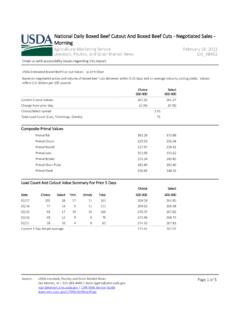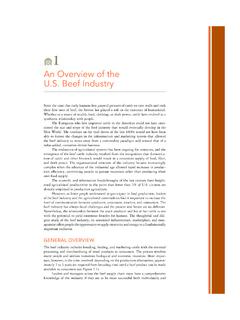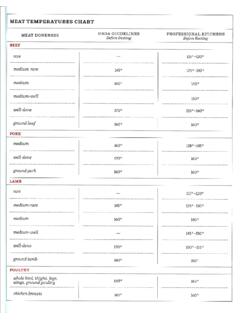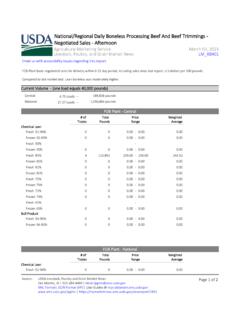Transcription of Beyond Meat’s Beyond Burger Life Cycle Assessment
1 Beyond Meat s Beyond Burger life Cycle Assessment :A detailed comparison between a plant-based and an animal-based protein sourceReport No. CSS18-10 September 14, 2018 Martin C. Heller and Gregory A. Keoleian 1 Client: Beyond Meat (Savage River) Title: Beyond Meat's Beyond Burger life Cycle Assessment : A detailed comparison between a plant-based and an animal-based protein source Report version: Report date: September 14, 2018 Regents of the University of Michigan On behalf of the Regents of the University of Michigan Document prepared by Martin C. Heller Senior Research Specialist +1 734-474-7166 Center for Sustainable Systems University of Michigan Under the supervision of Gregory A. Keoleian Peter M. Wege Endowed Professor of Sustainable Systems Director, Center for Sustainable Systems University of Michigan This study has been conducted according to the requirements of ISO 14040-2006, ISO 14044-2006, and reviewed according to ISO 14071-2014.
2 2 Table of Contents Table of Contents .. 2 List of Figures .. 4 List of Tables .. 5 List of Acronyms .. 6 Executive Summary .. 7 1. Introduction and Goal of the study .. 9 2. LCA Methodology .. 9 Scope of the Study .. 9 Product Systems .. 9 Product Functions and Functional Unit .. 9 System Boundaries .. 10 Time Coverage .. 11 Technology Coverage .. 11 Geographical Coverage .. 11 Allocation principles .. 11 Cut-off Criteria .. 12 life Cycle Impact Assessment Methodology and Impact Categories .. 12 Data Quality Requirements .. 13 Type and Format of the Report .. 13 Software and Database .. 13 Critical Review .. 13 3. life Cycle Inventory Analysis .. 14 Data Collection Procedure .. 14 Beyond Burger Product System .. 14 Electricity grid .. 14 Beyond Burger ingredients .. 14 Beyond Burger processing & packaging .. 16 Cold storage modeling.
3 18 Processing facility lighting .. 19 Beyond Burger distribution .. 19 Packaging disposal modeling .. 20 beef production: baseline for comparison .. 20 4. life Cycle Impact Assessment Results .. 23 Beyond Burger LCA results .. 23 Greenhouse gas emissions .. 26 Cumulative energy demand (energy use) .. 26 Land use (occupation) .. 26 Consumptive water use .. 27 Comparison with beef .. 27 5. Interpretation .. 28 Identification of Relevant Findings .. 28 Assumptions and Limitations .. 28 Boundary condition limitations .. 28 Spatial and temporal assumptions .. 29 beef comparison assumptions: considering beef from dairy and grass-fed beef .. 29 beef from dairy .. 30 Grass-fed beef .. 31 Results of Sensitivity Analysis .. 31 3 Modeling parameter sensitivity .. 31 Sensitivity to measured electricity use .. 32 Final product distribution sensitivity.
4 32 Post-consumer recycled content of tray .. 32 Allocation sensitivity .. 33 Data Quality Assessment .. 34 Additional inventory data quality Assessment .. 34 Model Completeness and Consistency .. 36 Conclusions, Limitations, and Recommendations .. 36 6. References .. 37 Annex A: Critical Review Statement .. 40 4 List of Figures Figure 1. life Cycle stages included in cradle to distribution system boundary of the Beyond Burger product.. 11 Figure 2. Photograph of Beyond Burger retail packaging.. 17 Figure 3. BB tray modeling details. Processes informed by personal communication with representatives at tray manufacturer and represent industry averages for this type of production.. 18 Figure 4. System boundary for beef LCA, as presented by Battagliese et al., 2015. The red border represents the portion of the modeled system used for comparison against the Beyond Burger .
5 Distribution to retail (orange box) is included in the comparison, but are modeled identically to the Beyond Burger case.. 21 Figure 5. Distribution of four impacts across life Cycle stages for the Beyond Burger .. 24 Figure 6. Relative comparison of impacts between beef (blue bars, set at 100% for each indicator) and Beyond Burger (red bars).. 28 5 List of Tables Table 1. Nutritional comparison of Beyond Burger and 80/20 beef .. 10 Table 2. Description of items included and excluded from Beyond Burger system boundary.. 10 Table 3. Summary of Beyond Burger ingredients and data used in modeling ingredient production*.. 15 Table 4. Beyond Burger packaging materials and modeling approaches .. 17 Table 5. Modeled fractions of disposal pathways for various materials.. 20 Table 6. Comparison of system boundaries and data sources between the Beyond Burger LCA and beef LCA.
6 22 Table 7. Summary of LCA results for beef production, per quarter pound boneless, edible beef (modified from (Thoma et al., 2017) to remove the effect of food loss).. 23 Table 8. Cradle to distribution LCA results for a one quarter pound Beyond Burger .. 25 Table 9. Percent contributions to GHGE from different stages and processes in the BB lifec Cycle .. 26 Table 10. Comparison of total cradle-to-distribution impacts of quarter pound Beyond Burger and quarter pound beef .. 27 Table 11. Cradle-to-farm gate LCA results for dairy beef production in the Northeastern .. 30 Table 12. Sensitivity of BB LCA model to a variety of assumed parameters. All values are shown relatve to the totals in Table 8.. 31 Table 13. Sensitivity of total BB results to changes in measured electricity .. 32 Table 14. Influence of distribution distance on total BB LCA results. All values are shown relatve to the totals in Table 8.
7 32 Table 15. Influence of postconsumer recycled content of PP tray on overall BB LCA results.. 33 Table 16. Percent differences from values in Table 8 for the ingredient stage and total impacts, when changing all Agrifootprint processes from economic-based allocation to either energy allocation or mass allocation.. 33 Table 17. Pedigree matrix used for data quality Assessment derived from (Weidema and Wesnaes, 1996) .. 34 Table 18. Data quality evaluation and importance of data contribution to life Cycle impacts.. 35 6 List of Acronyms BB Beyond Burger DS dry solids EPA Environmental Protection Agency GHGE greenhouse gas emissions GWP Global Warming Potential IPCC Intergovernmental Panel on Climate Change ISO International Organization for Standardization Los Angeles LCA life Cycle Assessment LDPE low density polyethylene LLPE linear low-density polyethylene Mph miles per hour NCBA National Cattlemen s beef Association NERC North American Electric Reliability Corporation PE polyethylene PP polypropylene SEC Specific Energy Consumption SERC SERC Reliability Corporation (formerly Southeast Electric Reliability Council)
8 US United States of America USMARC USDA s Roman L Hruska Meat Animal Research Center WARM Waste Reduction Model WECC Western Electricity Coordinating Council 7 Executive Summary Beyond Meat commissioned the Center for Sustainable Systems at University of Michigan to conduct a cradle-to-distribution life Cycle Assessment of the Beyond Burger , a plant-based patty designed to look, cook and taste like fresh ground beef . The purpose of the study is to compare environmental impacts chosen here as greenhouse gas emissions, cumulative energy demand (energy use), water use, and land use with those from typical beef production in the A secondary purpose is to highlight opportunities for improvement in the environmental performance of the Beyond Burger product chain and provide Beyond Meat with a benchmark against which improvement efforts can be measured. The primary audiences are both internal stakeholders at Beyond Meat as well as external customers, consumers, and interested stakeholders.
9 The Beyond Burger is considered functionally and nutritionally similar to beef ; therefore the chosen functional unit for comparison was defined as 4 oz. (quarter pound, kg) uncooked Burger patty delivered to retail outlets. This is the marketed patty size of the Beyond Burger and a standard consumer product size for beef patties. System boundaries included upstream ingredient and raw material supply (including farm production of agricultural crops), processing and packaging operations, cold storage, distribution to point of sale, and disposal of packaging materials. Retail and consumer stages, including potential losses at those stages, were excluded, as they were considered equivalent in both product systems. Beyond Meat provided specific information on production of the Beyond Burger , including directly measured processing electricity consumption. This was complemented with information from primary ingredient suppliers.
10 Environmental impact of beef production was drawn from an existing LCA study commissioned by the National Cattleman s beef Association (Thoma et al., 2017). The Beyond Burger LCA was evaluated using the same impact Assessment methods used in the beef study. Table ES1 provides a comparison of the total impacts from Beyond Burger and beef Burger . Based on a comparative Assessment of the current Beyond Burger production system with the 2017 beef LCA by Thoma et al, the Beyond Burger generates 90% less greenhouse gas emissions, requires 46% less energy, has >99% less impact on water scarcity and 93% less impact on land use than a pound of beef . Table ES1. Comparison of total cradle-to-distribution impacts of quarter pound lb. Beyond Burger and beef . Impact category Unit Beyond Burger beef patty GHGE kg CO2 eq. Energy use MJ characterized land use m2a eq.






